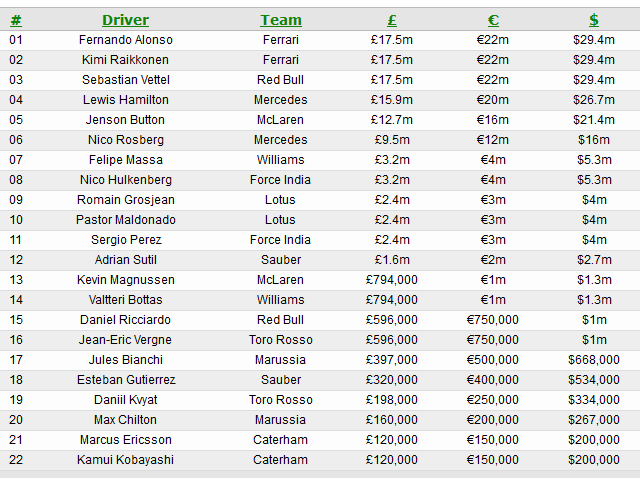
F1 Driver Salaries: A Deep Dive into the Million-Dollar World of Motorsport
Formula 1 racing is a spectacle of speed, skill, and immense financial power. While the roar of the engines and the thrill of overtaking captivate millions of fans worldwide, a significant aspect often overlooked is the astronomical salaries earned by the drivers themselves. These elite athletes command millions, sometimes tens of millions, of dollars annually, reflecting not only their on-track performance but also their immense marketability and contribution to team sponsorships.
This article delves deep into the complex world of F1 driver salaries, exploring the factors that determine these lucrative contracts, the disparities between drivers, and the future trends likely to shape compensation in this high-stakes sport.
Factors Determining Driver Salaries:
Several key factors influence the salary a Formula 1 driver can command. These include:
-
Performance and Championship Success: This is arguably the most significant factor. Consistent podium finishes, race wins, and ultimately, a world championship title, dramatically increase a driver’s earning potential. A driver with a proven track record of success is a valuable asset to a team, attracting sponsors and guaranteeing strong results. The difference between a driver with a single race win and a multiple-time champion can be tens of millions of dollars per year.
-
Experience and Reputation: Years of experience in F1, coupled with a strong reputation for consistency and professionalism, significantly enhance a driver’s negotiating power. Teams are willing to pay a premium for experienced drivers who are less likely to make costly mistakes and can contribute valuable insights to team strategy.
-
Marketability and Sponsorship Value: Beyond their driving skills, a driver’s marketability plays a crucial role. Drivers with strong personal brands, significant social media followings, and appeal to sponsors are immensely valuable. Their ability to attract lucrative sponsorship deals directly impacts the team’s revenue, and consequently, their salary. This often explains why drivers with less impressive racing records can still command high salaries.
-
Team Performance and Budget: The financial strength and performance of the team itself are critical factors. Top teams like Red Bull, Mercedes, and Ferrari generally have larger budgets and can afford to pay their drivers significantly more than smaller, less financially stable teams. The potential for championship success also plays a role, as drivers are more likely to accept slightly lower salaries if they believe the team has a genuine chance of winning.
-
Contract Negotiations and Agent Influence: The negotiation process and the driver’s agent play a pivotal role. A skilled agent can secure a significantly more lucrative contract for their client by leveraging their performance, marketability, and the competitive landscape. The timing of contract negotiations, the length of the contract, and the inclusion of performance-based bonuses all contribute to the final salary figure.
Salary Disparities and the Pay Gap:
There’s a significant disparity in salaries across the F1 grid. The top drivers, consistently performing at the highest level, earn tens of millions of dollars annually, while those further down the grid might earn just a fraction of that amount. This pay gap reflects the aforementioned factors, with top performers commanding premium salaries due to their on-track performance, sponsorship appeal, and overall value to the team.
This disparity is often a source of debate, with some arguing that it reflects a meritocratic system, while others highlight the social and economic implications of such vast differences in compensation. It’s important to note that the salaries are not just about driving ability but also encompass the significant commercial value each driver brings to the team.
Estimating Salaries: The Challenges and Speculations:
Precise figures for F1 driver salaries are often shrouded in secrecy, due to the confidential nature of these contracts. While some figures are leaked or reported by reliable sources, it’s difficult to obtain exact numbers. Various estimates and reports vary significantly, often depending on the source and the inclusion of bonuses and endorsements. Thus, any salary list should be considered an approximation rather than a definitive statement.
The Future of F1 Driver Salaries:
The future of F1 driver salaries is likely to be shaped by several factors:
-
Increased Revenue and Sponsorship: The growing popularity of F1, coupled with the expansion of races and new sponsorships, is likely to increase the overall revenue available to teams, potentially leading to higher driver salaries.
-
Budget Cap and Cost Control Measures: The introduction of a budget cap aims to level the playing field between teams. While this might limit the overall spending power of top teams, it could also lead to more competitive racing and a more balanced distribution of driver salaries.
-
The Rise of Young Talent: The emergence of talented young drivers could disrupt the established order and potentially lead to more competitive salary negotiations. Teams might be willing to pay a premium for up-and-coming drivers with high potential.
-
The Impact of Sustainability Initiatives: The increasing focus on sustainability within F1 might influence driver contracts, potentially including performance-based bonuses tied to environmentally friendly driving practices or team initiatives.
Conclusion:
F1 driver salaries are a fascinating reflection of the complex interplay between athletic performance, commercial value, and the overall financial landscape of the sport. While precise figures remain elusive, the immense sums involved highlight the dedication, skill, and risk-taking ability required at the pinnacle of motorsport. As the sport continues to evolve, the factors influencing these lucrative contracts will continue to shift, shaping the future of compensation in this high-octane world. The next generation of drivers will likely negotiate even more substantial contracts, driven by the ever-growing popularity and financial power of Formula 1.



